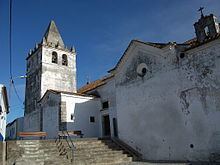Intermunic. comm. Alentejo Litoral Area 372.8 km² Postal code 7595 Area code 265 | Subregion Alentejo Litoral Municipality Alcácer do Sal Population 2,295 (2011) Region Alentejo | |
 | ||
Patron Nossa Senhora da Assunção Website | ||
Torrão ([tuˈʁɐ̃w]) is a civil parish and town, in the municipality of Alcácer do Sal, in the Portuguese district of Setúbal, bordering on the districts of Évora and the Beja. It is crossed by the river Sado. The population in 2011 was 2,295, in an area of 372.39 km².
Contents
- Map of TorrC3A3o Portugal
- History
- Geography
- Economy
- Archeological
- Civic
- Religious
- Notable citizens
- References
Map of Torr%C3%A3o, Portugal
In 2012, Torrão was, in terms of area, the third-largest parish in Portugal but, due to a territorial reorganization, since 2013 has been the sixth-largest parish in the country.
History
Human presence can be traced back to the late Neolithic or Chalcolithic from excavations made at Monte da Tumba in the early 1980s.
The archeologist José Leite de Vasconcelos at the end of December 1895. discovered various constructs, including dolmens (such as the Dolman of Torrão), that were in various states (some on the ground, others upright and inclined). Along with other sites, Pedra de Anta suggests the existence of many megalithic monuments in this region, but their absence may indicate that the large stones may have been repurposed for other purposes. The dolmen Lapa de São Fausto (locally referred to as Fráusto or Fragusto) was named after a saint who had supposedly appeared on the site. Near this site are the ruins of a church (dated to its reconstruction in 1645), but where Pinho Leal referred to the existence of a Roman temple, dedicated to Jupiter. J. Leite de Vasconcelos had authored studies claiming the discovery of Neolithic instruments, which dsignated: "instruments of copper and bronze".
From the Roman epoch, the eminent archaeologist noted a small construction on the outskirts of the village, that could have served to collect water, and roof tile fragments scattered around the structure. Today a modernist fountain, at the time the spring was referred to as Fonte Santa, and had been rumoured to have originated by the Arab residents of the region. Older records from the local prior date from 1758, and referring to Torrão indicate: "I do not know if there's a spring or celebrated lake, yes, a fountain called Fonte Santa,...and they say that it is a work of the Moors, which they do not doubt, because the land smells of them, and we can see that the majority of the people are black and disguised, or now like charcoal". The Arab occupation of the region ended with the reconquest of Alcácer do Sal in 1217, when the territories in the shadow of the town was conquered.
In São João de Azinhais was a tombstone with inscription, and barrel-like stone, use for burials in the Alentejo at the time. These mounds, conform Romanesque practices, mark the beginnings of Christian occupation. After the Reconquista the seigneury was handed over to the Order of Saint James (under the patronage of the Church of Santa Maria), beginning a period of ownership since 1260, and establishing its municipal history. The village was actually larger near the hermitage of São Roque for a time, owing to the number of foundations, but may have been disseminated by the effects of the Black Death.
Geography
Torrão is one of six parish of Alcácer do Sal, located southeast of this municipality, in the South part of the Setúbal district.
It's in the limits of this parish that stand united the Setúbal, Évora and Beja districts and therefore the NUTS III Alentejo Litoral, Alentejo Central e Baixo Alentejo.
Torrão has borders with the Viana do Alentejo municipality, in the northeast, from the Évora district, by Alvito, East and Ferreira do Alentejo, south, in the Beja district and Grândola, south and west, also in the district of Setúbal.
The parish is divided by the Xarrama River, on is way to meet the Sado River. In this path, just after passing the village of Torrão, the Xarrama forms an artificial lake, created by the Trigo de Morais Dam.
Economy
From Torrão can be originated several Geographical indications and traditional specialities:
